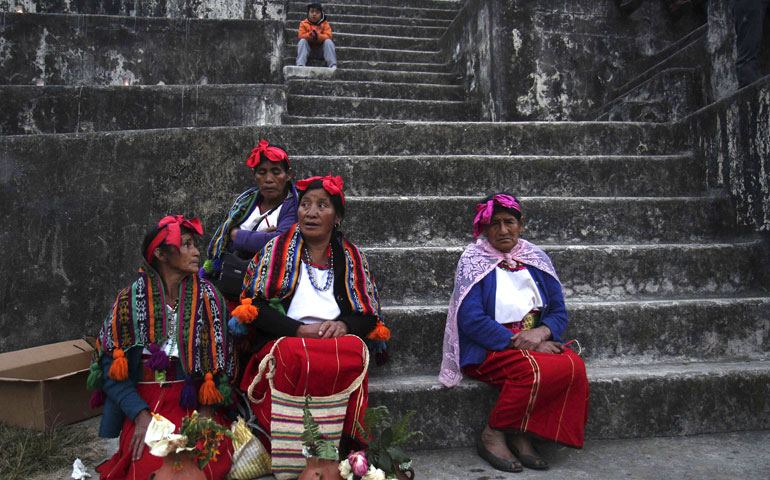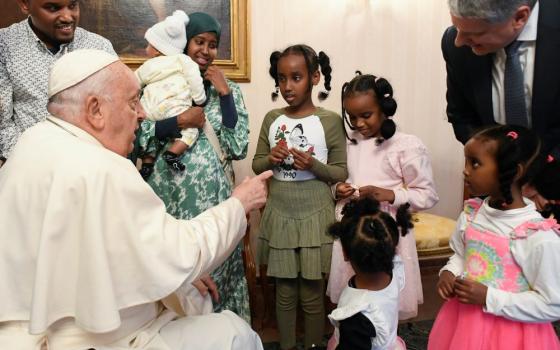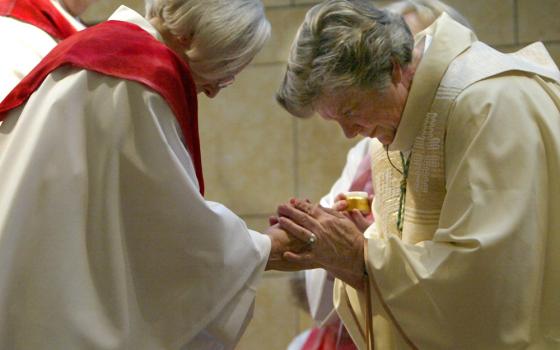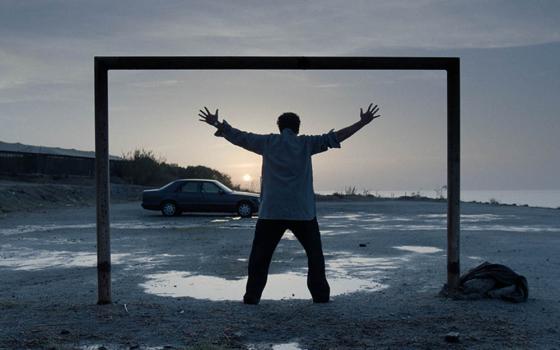
Women get ready to take part in a Mayan ceremony at the Zaculeu archaeological site in Huehuetenango, Guatemala, Dec. 21, 2012. (Newscom/ZUMA Press/STR)
Julia Esquivel, internationally known poet and longtime activist, lives quietly in a pleasant home, her front yard filled with blooms, in the heart of Guatemala's capital. The 82-year-old, who penned a searing prayer of lament and beseeching at the height of barbarity here during the 1980s, was driven into exile for eight years for opposing the government. So she doesn't arrive at hope lightly, but one late afternoon in June, she spoke in emotional terms about her hope for the future of Guatemala.
"There are people who have been victims of violence, who have suffered terrible violence, women who have been raped, who today are working with other women to process the rage that they feel and to recover their essential humanity," she said. "That to me is a miracle."
"The other thing that seems to be incredible when I think about it is the communities, rural communities, that continue to organize themselves and as they organize they stand up against the exploitation of the mining companies," she said, referring to clashes between mostly indigenous communities and mining companies over land use and environmental issues. "It is amazing. How is it possible that after everything they have experienced, all that they have suffered, these communities have the strength to unite and resist? It's admirable."
Martin Rodríguez Pellecer, younger by 50 years, was born about the time Esquivel went into exile. As editor of the online investigative journal Plaza Pública, a project initiated by the Jesuit-run Universidad Rafael Landivar in Guatemala City, he embodies 21st-century reasons for hope in the country's future. Rodríguez has a master's degree in Latin American studies and formerly worked for Prensa Libre, one of Guatemala's main daily newspapers. On a sunny afternoon in June, he sat in a university food court and spoke openly of the enterprising journalism the relatively new publication has undertaken -- deep digs into such issues as child labor on sugar plantations, and government and business corruption. With a staff of 15, including nine journalists, tucked into office space on this beautiful campus, Rodríguez is tackling issues today that continue to emanate from the cultural, political, social and economic imbalances that once fueled hideous violence.
Esquivel and Rodríguez represent two points on an arc of history that saw Guatemala move from an experiment in democracy and independence from 1944 to 1954 to the target of a CIA-engineered overthrow of an elected government during the anti-communist nervousness of the 1950s, to a string of military dictators that culminated in unspeakable carnage, described by the United Nations as genocide, in the 1970s and 1980s. Peace accords were signed in 1996, but that was a bit like crafting an agreement to stop natural disasters. The ongoing inequity and racist attitudes toward the indigenous Mayan population didn't end with those accords and the tremors continue to be felt beneath the apparent calm of today.
My first step into the arc of Guatemala's modern history occurred in November 1981 with the aid of Dennis Smith, a Presbyterian lay missioner who served as guide and interpreter. It was only in retrospect that I realized the brief visit occurred during one of the most intense periods of violence in Guatemala's 36-year civil war.
We didn't see any violence that trip, only the results of it. Blown-up restaurants and buses, bullet-pocked and exploded police stations, huge trees felled as a means of blocking roads, all mostly the work of armed resistance to the government. Relentless and nearly paralyzing fear and suspicion run rampant; all institutions of civil society, from universities to churches, were under constant assault, most of it the handiwork of the government and its various military and paramilitary forces. Over days of clandestine interviews during a large loop of travel that took us from Guatemala City to Quetzaltenango in the west to the country's southern coast and back, we heard tales of almost unimaginable state-sponsored violence: disappearances, torture, mass slayings, nighttime killings. My colleague arrived at a church outing to stone silence. Minutes before, he learned, a military vehicle had pulled up and soldiers had come into the crowd and taken a man away. That was the way people disappeared here.
My last interview of that trip was with a young doctor, one of two remaining in a university department that specialized in rural medicine. Death squads had shot and killed the other four at night, in front of their families. Soon after our interview -- which moved from one place to the next anytime someone came near -- I learned that he and his family had safely escaped. He was working as an orderly in Southern California.
It was a numbing dose of reality -- ultimate questions dragged into the public square, the answers to which often led to life-or-death decisions. It was an all-or-nothing drama played out in a setting of breathtaking natural beauty, dizzying cultural and biodiversity, all layered in spirituality and religious practice that ranged from ancient Mayan customs through a quickly evolving Catholicism to the evangelicalism of the U.S. heartland. The mix proved an irresistible allure, and I was forever hooked on Guatemala.
Lutheran theologian and historian Martin Marty, introducing the 2003 documentary "Precarious Peace: God and Guatemala," a project in which Smith played a major role, asked: "What does it mean to be people of faith in a global society where religion and politics are inevitably entangled?"
That question, a perennial provocation for the broad Christian community, took on an unsettling specificity in Guatemala of the 1970s and '80s and continues to haunt. For if we believe nonviolence is a constituent part of Christian Scripture, if we believe love of enemy is an essential element of the message, then what does it mean? In real time? What is it like to have lived in a place, and at a time, where men, women and children were indiscriminately slaughtered because they were perceived to be "the water" in which "the fish" of revolution swam, and thus expendable by whatever means possible? What decisions do you make? With whom do you associate? With whom do you connect as the stories, beyond unspeakable, keep piling up around you? And when the violence has exhausted itself, what does the recovery look like?
* * *
Even at its worst, la violencia, the shorthand now used to describe the whole wretched display of horrors in Guatemala, remained contained, even hidden, not only from the wider world but also within the country itself. The point was made during a lunch in the Western Highlands by 28-year-old Paulina Aguilar, who teaches home economics. She said she knew little about the war until, as part of her college studies and thesis, she began to investigate the history of communities in which she was working.
From her grandmother, she learned that while it was not especially dangerous in the area where she lived during the period of violence, the community nevertheless kept hearing about bodies of people from El Quiche being dumped in a nearby ravine along a highway. Military commanders would also regularly come into the community and take men to force them into military service.
Aguilar said a grandfather "was taken and forced to serve in the military and undoubtedly did things that were deeply against his views and morality." But there is little conversation about such things, she said.
The realities of that era were further unearthed for her, she said, by the documentation compiled by the Catholic church in a three-year effort known as the "Interdiocesan Project to Recover the Historic Memory." It is widely known by its acronym as the REMHI project. The report it released in 1998 is titled "Guatemala: Nunca Más ['never again']."
Aguilar learned, too, from the stories of friends who had relatives who were forced into exile because of their politics. In a more vivid way -- and perhaps evidence of how globalization has shrunk not only distance but time -- she began to view documentaries about various massacres. She found them on YouTube.
It is impossible to predict whether the truth of what occurred in Guatemala under extremely oppressive, U.S.-supported governments will ever come fully to light, but the importance of trying to get at it is difficult to overstate.
Of the civil wars raging in Central America at the time, Guatemala's was, in terms of numbers killed and the extremes of atrocities committed, far worse than anything experienced, for instance, in neighboring El Salvador or a country away in Nicaragua. The most used figure of the number who died in Guatemala's civil war is 200,000 in a country with a population of about 8 million in 1980. That population has grown to more than 12 million today.
It is no longer just an open secret but a matter now of exhaustively documented fact that unlike any other country in the region, Guatemala confronts the United States, even many years later, with the worst of itself.
Guatemala was the petri dish for U.S. experiments in counterterrorism, including some of its worst expressions, from government overthrow to violent intimidation of large segments of the population. The country also became an involuntary laboratory for figuring out what the Christian faith and the Gospel require in those extreme moments when state security and fear of enemies within and without is used as justification for mass violence. Religion in such circumstances could be bent to hideous ends. One of the points of pride today throughout many sectors of Guatemalan society is the recent trial that found former military dictator Efraín Ríos Montt, trained at the U.S. Army's School of the Americas, guilty of genocide. Ríos Montt, however, was also an accomplished evangelical lay preacher, often appearing in public with floppy Bible in hand. He was a darling of both the Reagan administration and the religious right in the United States.
On the other side of the conflict, at least 20 priests and hundreds of catechists were killed over the course of civil upheaval, mostly targets of state-aligned military, police or paramilitary death squads. Other priests gave up their ministry and took up arms.
Postwar, the church attempted to preserve the history of that era, confronting the unvarnished truth of the violence and its aftermath. "We want to contribute to the construction of a country that's different. That's why we are recovering the memory of the people," Bishop Juan Gerardi declared on April 24, 1998, the day he presented the report of the REMHI study he had led. "This path has been and continues being full of risks, but the construction of the reign of God is a risky task." Gerardi was eerily prescient in his understanding of how risky this business is. Two days after he made the statement he was murdered by members of the military, which his report had severely criticized.
The history being made in Guatemala today is not nearly as dramatic -- or at least not as abundant in deadly drama -- as that of the recent past, but it may be even more significant in the long run. Smith has lived in Guatemala for 35 years (see accompanying story). He has been immersed long enough and deeply enough to have grown beyond the simplicities of the right and left in both religious and civic spheres. Experience has stripped him of any romantic notions held in some quarters about the poor and their collective nobility or about armed revolt, no matter how elevated and compelling the cause. At the same time, experience has also given him a heightened sense of justice, of the redemptive role believers must play in the here and now and a greater appreciation for ambiguity as an inextricable part of the human condition.
A few months ago, I asked Smith if he would return with me to Guatemala and retrace that original trip (as happens with missioners, he was reassigned and he and his family are currently living in Buenos Aires) to reflect on his past here and what it meant in his evolution as a Christian, a U.S. citizen and someone who had chosen to make Guatemala his home.
He didn't hesitate to join me, and he did much more, incorporating into our conversation interviews all along the way, sometimes interpreting for hours with few breaks. And he also did all of the driving.
* * *
In square miles, Guatemala is almost exactly the size of Ohio. But it seems a lot larger. For instance, as the crow flies, the distance between Guatemala City and Quetzaltenango to the west is 68 miles. But it takes three hours to get there by car. Part of that distance is a gradual, winding climb to nearly 2 miles high, to more than 10,300 feet above sea level in the town of Cumbre de Alaska, one of the highest points on the Pan American Highway.
This is a long climb through breathtaking vistas, with volcanoes popping into sight over valleys that seem to stretch endlessly; at other points the earth appears to drop out of view into severe barrancos, or ravines. All along the route in this wildly diverse and fertile country are examples of indigenous farming on hillsides with grades that would make a mountain goat dizzy. The fields are evidence of a kind of cultural evolution made necessary over centuries by wave after wave of exploitation of the indigenous population. When people keep taking your land, you apparently learn to grow corn on the sides of mountains. Smith says there's an old joke that Guatemala's a country where you can break your leg falling out of your cornfield.
Smith knows these roads and those leading down out of the Western Highlands to the southern coast. He knows the turnoffs, the major intersections, where this or that massacre occurred, towns where he held meetings, coffee fincas where early on he showed religious films with a 16 mm movie projector run by a portable generator and shown on a sheet strung between bamboo poles.
Much on the surface is different now. The roads are improved; some that once were dirt tracks are paved. Towns that once were small obstacles to travel have begun to sprawl and are jammed with traffic. But many of the systemic tensions and social and economic divisions today persist at some level today.
Guatemala, however, is undeniably a different place 30 years on. If first impressions count, the country has outdone itself with its new airport, all polished stone, gleaming and digitized. Gone is the grim old building made even more foreboding in 1981 by the different levels of police and military, bearing automatic weapons, who seemed at times to be tripping over one another. The armed presence carried through in every population center we visited at the time. All sides in the conflict were nervous. We were under constant -- and obvious -- surveillance.
That level of muscle-tightening fear no longer exists in Guatemala. People don't look over their shoulders constantly when talking about conditions in the country. Conversations no longer need to move from one location to another for fear of being overheard and reported.
The warnings today are about drug lords and gang violence, human trafficking and the crime that goes with severe poverty in urban centers. The body count of those killed each year remains in the thousands and there is a particularly persistent problem of femicide. But people like Esquivel know the differences, and she and others never fail to point out what they see as the one very public marker of progress: the trial of the notorious Ríos Montt, the former president-by-coup and military leader accused of overseeing genocide. He was convicted on May 10.
It seemed not to matter to any of those interviewed that Ríos Montt's initial conviction was overturned in less than a month or that debates still go on, even among those who are convinced he committed atrocities, about whether genocide was the correct charge. Most of those interviewed believe he will face new legal procedures in the coming months. More important than the conviction, it is clear, was the fact that he was hauled into court and that scores of indigenous witnesses to the horrors -- men and women who had lost spouses, friends, children -- were able to place their accounts on the record. Over and over the court and whoever else in the world was interested could now know what these people had seen and heard. And they were taken seriously.
Rodríguez goes further. Nowhere, he said in a phone interview following our chance meeting on the campus, has a country put as many former military leaders, presidents and powerful businessmen on trial and in jail for breaking the law -- from human rights violations to drug and human trafficking. He said the Ríos Montt prosecution, even though it's been interrupted, is proof that "progress has been made in the area of justice."
And the mere fact that Rodríguez's publication is able to break stories about official and business corruption and editorially criticize institutions without fear of violence is, for him, another significant sign of progress. The publication is not without its detractors and those who wish it would go away, but digging into such stories no longer means an automatic death sentence.
That a Jesuit university, historically a rather conservative institution in Guatemala, sponsored Plaza Pública is a further indication of the significance of the church's role in raising difficult issues in civil society.
Part 2: Bishop Álvaro Ramazzini Imeri is an exemplar of a very public Catholic raising difficult issues.
See related story: Missioner came of age in Guatemala
[Tom Roberts is NCR editor at large. His email address is troberts@ncronline.org.]



